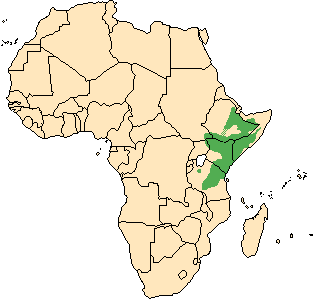![]() Return to
Artiodactyla
Return to
Artiodactyla
Classification
|
 Tragelaphus
imberbis
Tragelaphus
imberbis
Lesser kudu
![]()
Taxonomy
The taxonomic record (above) is taken from Wilson and Reeder (1993). T. australis is a synonym for Tragelaphus imberbis.
 |
 |
 |
Click on the pictures above for a larger view of the
photographs
|
||
General Characteristics
Body Length: 110-140 cm / 3.6-4.6 ft.
Shoulder Height: 90-110 cm / 3-3.7 ft.
Tail Length: 25-40 cm / 10-16 in.
Weight: 56-105 kg / 123-231 lb.Females and young are a reddish-brown, while bulls turn blue-grey with age. There are 11-14 very distinctive white stripes on the sides, a white patch on both the upper and lower throat, two white cheek spots, and a chevron between the eyes. The slender legs are tawny with black and white markings. Males have a small mane on the nape of the neck and along the spine. There is no beard on the throat (imberbis = not bearded). The spiraled horns are found only in the males and grow 60-90 cm / 2-3 feet long, having two twists.
Ontogeny and Reproduction
Gestation Period: 8 months.
Young per Birth: 1
Weaning: After 6 months.
Sexual Maturity: Females by 15 months, males mature sexually at this time, although they do not become socially mature until their 4th or 5th year.
Life span: Up to 15 years.There is no fixed breeding season, so calves are born throughout the year. After birth, the young lie concealed away from their mother.
Ecology and Behavior
The lesser kudu is primarily active at night and in the early morning, seeking shelter shortly after sunrise. The alarm call is a sharp bark. The lesser kudu is shy and wary, and when startled flees with the tail held up, revealing the white underside. Leaps of up to 2 meters / 6.6 feet have been recorded, though these are not common. Individual home ranges average 2.2 square kilometers for males and 1.8 square kilometers for females. These areas overlap extensively with no apparent territoriality, and different parts are used at different times of the year. Population density rarely exceeds 1 animal per square kilometer.Family group: Mixed or single sex troops of 2-5 individuals, rarely up to 24. Old bulls are solitary.
Diet: Primarily leaves, sometimes grasses and fruit. Lesser kudu rarely drink.
Main Predators: Leopard, Cape hunting dog, lion.
Distribution
Dry thorn brush and forests in Eastern Africa.Countries: Djibouti [RE], Ethiopia, Kenya, Saudi Arabia? [RE], Somalia, Sudan, Tanzania, United Republic of Uganda, Yemen? [RE] (IUCN, 2002).

Range Map (Redrawn from IAE, 1998)
Conservation Status
The lesser kudu is classified as low risk, conservation dependent by the IUCN (2002), and is not listed by CITES.
Remarks
Kudu, or koodoo, is the Hottentot name for the greater kudu, a close relative. The 'lesser' denotes the smaller size and lack of mane of this antelope when compared to the greater kudu. Tragos (Greek) a he-goat;.elaphos (Greek) a deer; in combination referring to an antelope. Imberbis (Latin) unbearded: a reference to the absence of a mane on the throat, as found in the greater kudu.
- French
- Petit koudou (Walther, 1990)
- German
- Kleiner Kudu (Walther, 1990)
Literature Cited
IEA (Institute of Applied Ecology) 1998. Tragelaphus imberbis. In African Mammals Databank - A Databank for the Conservation and Management of the African Mammals Vol 1 and 2. Bruxelles: European Commission Directorate. Available online at http://gorilla.bio.uniroma1.it/amd/amd221b.htmlIUCN (International Union for Conservation of Nature and Natural Resources). 2002. 2002 IUCN Red List of Threatened Species. Available online at http://www.redlist.org/
Kingdon, J. 1997. The Kingdon Field Guide to African Mammals. Academic Press, London and New York: NaturalWorld.
Nowak, R. M. [editor]. 1991. Walker's Mammals of the World (Fifth Edition). Baltimore: The Johns Hopkins University Press.
Walther, F. R. 1990. Spiral-horned antelopes. In Grzimek's Encyclopedia of Mammals. Edited by S. P. Parker. New York: McGraw-Hill. Volume 5, pp. 344-359.
Wilson, D. E., and D. M. Reeder [editors]. 1993. Mammal Species of the World (Second Edition). Washington: Smithsonian Institution Press. Available online at http://nmnhwww.si.edu/msw/
Additional Resources
Alden, P. C., R. D. Estes, D. Schlitter, and B. McBride. 1995. National Audubon Society Field Guide to African Wildlife. New York: Chanticleer Press.Benirschke, K., D. Rueedi, H. Mueller, A. T. Kumamoto, K. L. Wagner, and H. S. Downes. 1980. The unusual karyotype of the lesser kudu Tragelaphus imberbis. Cytogenetics and Cell Genetics 26(2-4): 85-92.
East, R. (compiler) 1998. African Antelope Database. IUCN/SSC Antelope Specialist Group.
Janecek, L. L., R. L. Honeycutt, R. M. Adkins, and S. K. Davis. 1996. Mitochondrial gene sequences and the molecular systematics of the artiodactyl subfamily Bovinae. Molecular Phylogenetics and Evolution 6(1): 107-119.
Leuthold, W. 1971. Studies on the food habits of lesser kudu in Tsavo National Park, Kenya. East African Wildlife Journal 9: 35-45.
Leuthold, W. 1979. The lesser kudu Tragelaphus imberbis: ecology and behavior of an African antelope. Saeugetierkundliche Mitteilungen 27(1).
Mitchell, A.W. 1977. Preliminary observations on the daytime activity patterns of lesser kudu in Tsavo National Park, Kenya. East African Wildlife Journal 15: 199-206.
Read, B., D. Vogt, and E. W. Houston. 1990. Breeding program for the lesser kudu Tragelaphus imberbis in North America. Zoo Biology 9(4): 287-296.
Vahala, J. 1992. Reproduction of the lesser kudu (Tragelaphus imberbis) at Dvur Kralove Zoo. Zoo Biology 11(2): 99-106.
Return to Artiodactyla

![]()
© Brent Huffman, www.ultimateungulate.com |
|
|